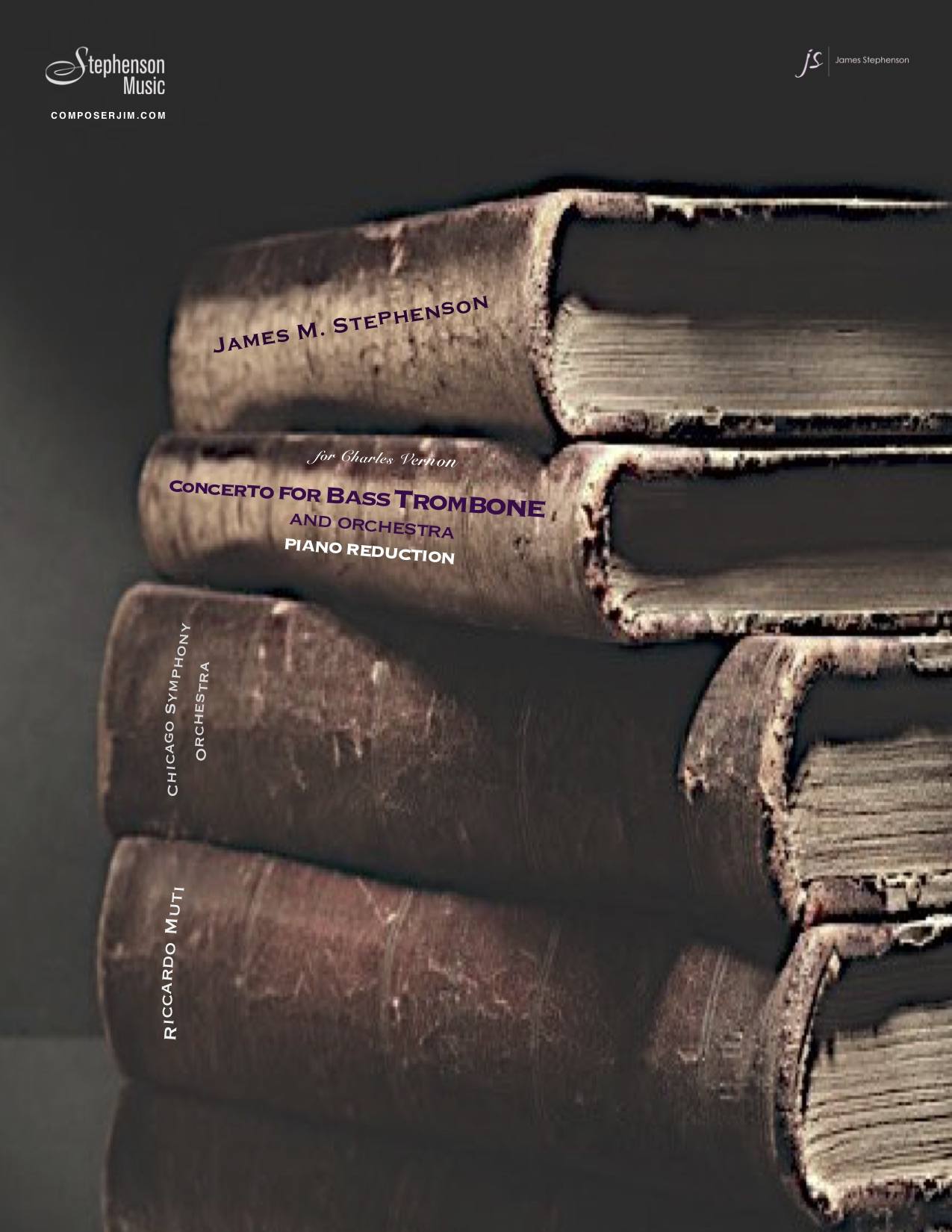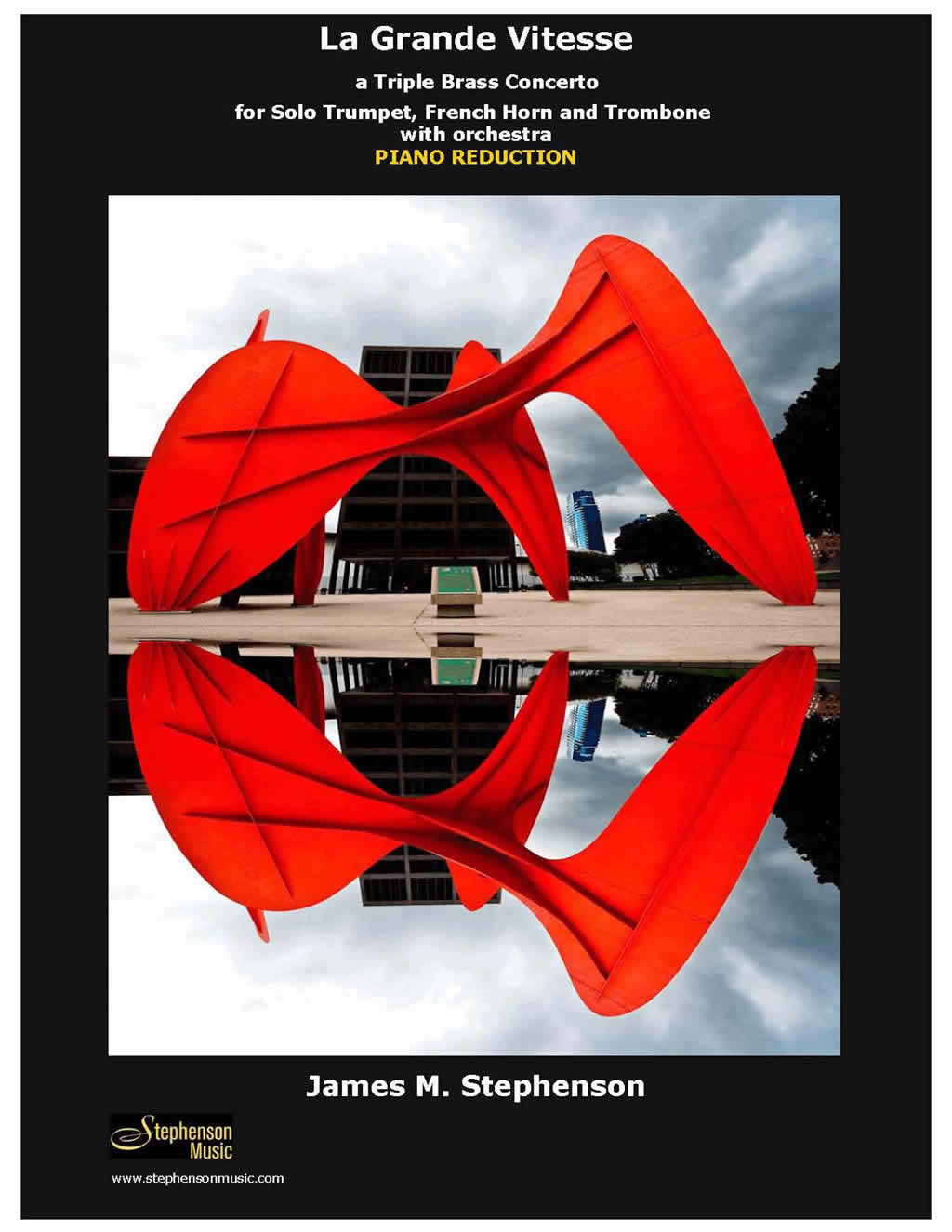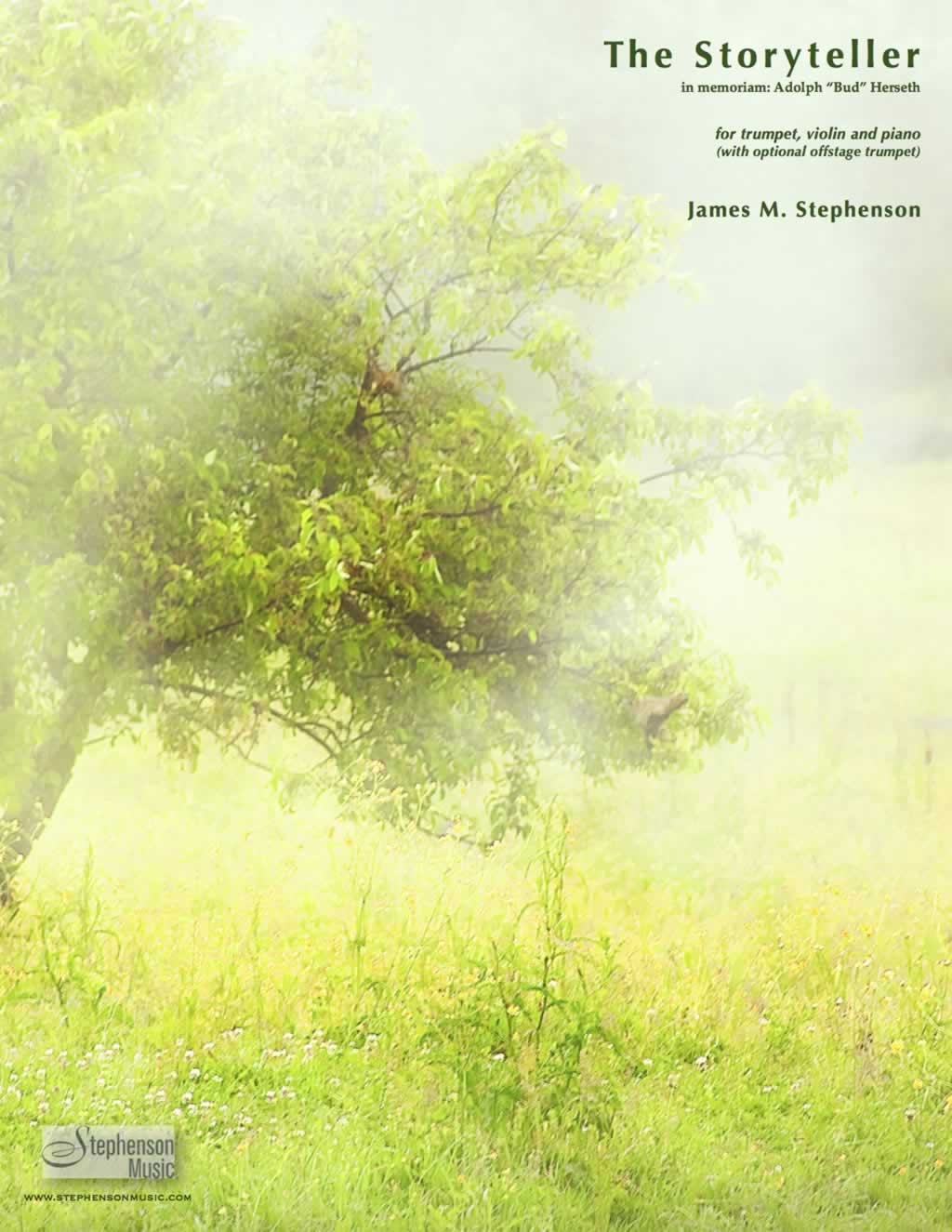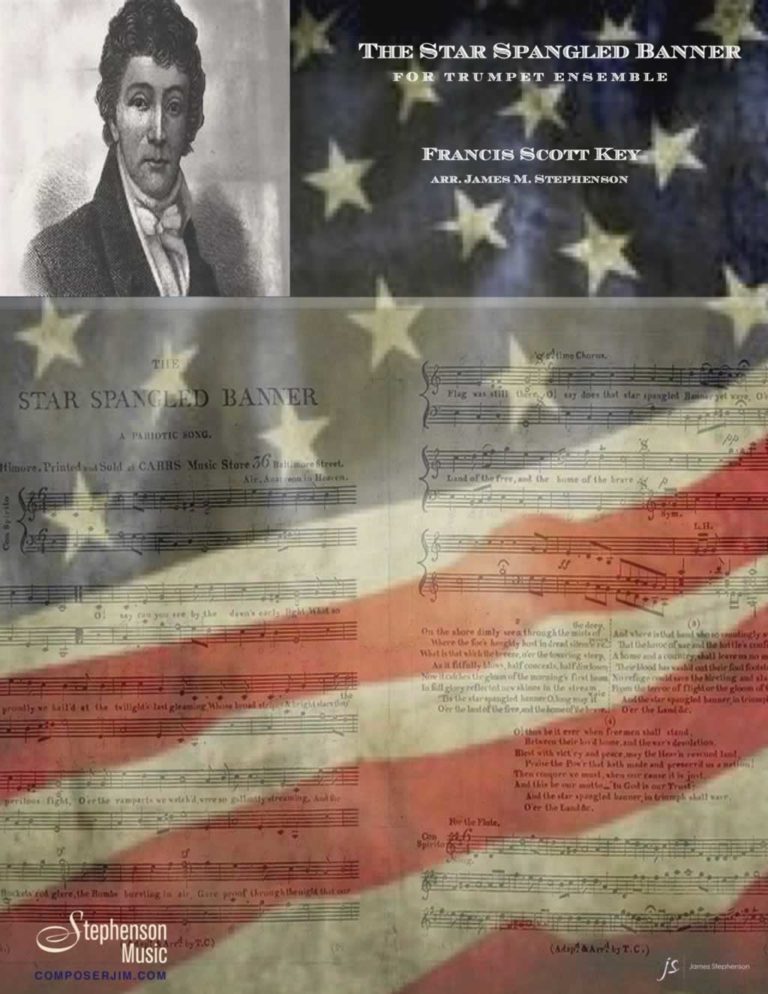Concerto for Bass Trombone
$35.00
Description
[vc_row][vc_column][vc_column_text]Concerto for Bass Trombone and Orchestra
by James M. Stephenson (b. 1969)
for Charles Vernon, and the Chicago Symphony Orchestra and Music Director Riccardo Muti
duration: 22’30”
Piano Reduction created by Maddie Stephenson[/vc_column_text][/vc_column][/vc_row][vc_row css=”.vc_custom_1561743074936{margin-top: 3% !important;margin-bottom: 3% !important;padding-top: 20px !important;padding-right: 20px !important;padding-bottom: 20px !important;padding-left: 20px !important;background-color: #3187a5 !important;}”][vc_column][bsf-info-box icon=”Defaults-quote-left” icon_size=”48″ icon_color=”rgba(255,255,255,0.75)” title=”Riccardo Muti; Music Director, Chicago Symphony Orchestra” pos=”left” desc_font_style=”font-style:italic;” title_font_size=”desktop:26px;tablet:26px;tablet_portrait:26px;mobile_landscape:24px;mobile:22px;” title_font_line_height=”desktop:38px;tablet:38px;tablet_portrait:38px;mobile_landscape:34px;mobile:30px;” title_font_color=”#ffffff” desc_font_size=”desktop:20px;tablet:20px;tablet_portrait:20px;mobile_landscape:18px;mobile:18px;” desc_font_line_height=”desktop:30px;tablet:30px;tablet_portrait:30px;mobile_landscape:28px;mobile:28px;” desc_font_color=”#ffffff” css_info_box=”.vc_custom_1561754604570{margin-top: 3% !important;margin-bottom: 3% !important;padding-top: 0px !important;padding-bottom: 0px !important;}”]It’s a wonderful piece, which I enjoyed more and more throughout the week. It’s truly a well-crafted piece[/bsf-info-box][/vc_column][/vc_row][vc_row][vc_column][vc_column_text]
Instrumentation:
solo bass trombone
piccolo (doubling on alto flute), 2 flutes (flute 2 doubling on alto flute)
2 oboes, 1 English horn
2 αA/Bα clarinets (clarinet 1 doubles on Eα clarinet), bass clarinet
2 bassoons, contrabassoon
4 French horns in F 3 trumpets in C
2 tenor trombones
tuba
timpani + 3 percussion
percussion instrumentation:
P I: vibraphone, triangle, glockenspiel (shared), cymbals a2, marimba (shared) cabasa, 2 small polished stones, xylophone (shared), chimes (shared)
P II: suspended cymbals (18″ + 16″), snare drum, cymbals a2, marimba (shared) tam tam, 4 toms, shakers, xylophone (shared), glockenspiel (shared), chimes (shared) claves, wood blocks, crotales – bowed (shared); and bucket of water (for crotale dips)
P III: chimes (shared), triangle, bass drum, wood blocks, crotales (shared), suspended cymbal cymbals a2, snare drum, tambourine, Thai gong (1 – pitched low A)
harp
strings
Program Notes – by the composer:
When Charlie Vernon first told me in November of 2015 that I would be writing a new bass trombone concerto for him, he highlighted two things:
1) that it be the “most profound, beautiful and lasting musical event to be played on the bass trombone” (thanks, Charlie, I’ll do my best…) and:
2) that it would be “a great story, like a book you can’t stop reading.”
As I thought about these requirements, I began to think about something I consider pretty profound: life itself. Perhaps this is because at the time of the world premiere I will be 50 years old, when one starts thinking about such heavy subjects; but suffice it to say that it seemed a good time to write something that heeded the significance of life. In thinking about life, I kept coming back to the rhythms of life, and its ups and downs. This idea spurred on my initial inspiration, and I begin to feel a pulse that would inspire the entire work.
A pulse, of course, fits nicely into both worlds: life and music. I coupled this early on with a rising
note-motif of A-B-C, which serendipitously couples nicely with Charlie’s idea of this piece being
like the reading of a book.
And so the piece evolves, with the main A-B-C motif generally revealed in rising fashion in Chapter I,
and in falling fashion in Chapter II. Ups and downs. The first movement is that of a bass trombone coming of age. It enters the world boldly, but then goes through moments of confusion, nervousness, development, and finally, confidence and fun (the latter with jazz references, in honor of one of Charlie’s favorite mediums), as the movement ends with the protagonist at its height. The concerto has travelled from A minor to A Major. Life is good.
The second movement (“Chapter II”) picks up right where the first left off. It is audacious music brimming with pomposity, and with resolute puffed chest. As it continues, the motif reverses, and lyrical music rides on top of contrapuntal orchestral scoring, as if wisdom has taken the place of hustling angst. The music builds, pulses, and grows, and portrays heart-wrenching “life-moments”, before finally beginning to subside back to a period of much reflection and thought. There is a direct segue (no pause) into the Epilogue, now back in A minor, which, for a while, remains almost still. But life is re-affirmed, and the music continues to pulse, and ends rapturously in A Major, with the bass trombone still at the top of its game.
I grew up going to Chicago Symphony concerts as a child. Then, as a young trumpeter, I often dreamt of some day sitting and performing on the stage at Symphony Center in Chicago. Even though that dream won’t happen, I am thrilled to have a world premiere of my music with my favorite orchestra, on that very stage, and under the direction of Maestro Riccardo Muti. I have Charlie Vernon to thank for this, and I can only hope that my music will serve thebass trombone and music world well, and come as close as possible to Charlie’s vision of a “profound, beautiful, and lasting” creation.
Jim Stephenson; November 6, 2018 [/vc_column_text][/vc_column][/vc_row][vc_row css=”.vc_custom_1561745392706{margin-top: 3% !important;margin-bottom: 3% !important;}”][vc_column][vc_column_text]
World Premiere Image Gallery
[/vc_column_text][vc_masonry_media_grid element_width=”3″ gap=”20″ grid_id=”vc_gid:1610466893687-99ed0a65-a421-3″ include=”13686,13685,13684,13683,13682,13681,13680″ css=”.vc_custom_1561754127188{margin-top: 3% !important;}”][/vc_column][/vc_row][vc_row][vc_column][vc_column_text]
Reviews & Applause
[/vc_column_text][/vc_column][/vc_row][vc_row css=”.vc_custom_1561743074936{margin-top: 3% !important;margin-bottom: 3% !important;padding-top: 20px !important;padding-right: 20px !important;padding-bottom: 20px !important;padding-left: 20px !important;background-color: #3187a5 !important;}”][vc_column][bsf-info-box icon=”Defaults-quote-left” icon_size=”48″ icon_color=”rgba(255,255,255,0.75)” title=”Hyde Park Herald – M.L. Rantala (Music Critic)” read_more=”title” link=”url:https%3A%2F%2Fhpherald.com%2F2019%2F06%2F19%2Fmuti-leads-cso-in-wide-ranging-program%2F|||” pos=”left” title_font_style=”text-decoration:underline;” desc_font_style=”font-style:italic;” title_font_size=”desktop:22px;tablet:22px;tablet_portrait:22px;mobile_landscape:20px;mobile:18px;” title_font_line_height=”desktop:32px;tablet:32px;tablet_portrait:32px;mobile_landscape:30px;mobile:28px;” title_font_color=”#ffffff” desc_font_size=”desktop:18px;tablet:18px;tablet_portrait:18px;mobile_landscape:16px;mobile:16px;” desc_font_line_height=”desktop:28px;tablet:28px;tablet_portrait:28px;mobile_landscape:26px;mobile:26px;” desc_font_color=”#ffffff” css_info_box=”.vc_custom_1561754331990{margin-top: 3% !important;margin-bottom: 3% !important;padding-top: 0px !important;padding-bottom: 0px !important;}”]”The biggest revelation of the concert was the new work by American composer James Stephenson. His Bass Trombone Concerto was commissioned for the CSO and for bass trombonist Charles Vernon. Stephenson has created complex music, often with many layers, and Vernon, for the most part, knew how to stand out and be heard. He had muscular sound and remarkable control. He moved from mystery to yearning, from bold declarations to quiet tremblings. Stephenson gave the bass trombone his moment to shine and Vernon fully embraced the opportunities.
Muti led the orchestra in a sympathetic and committed performance, offering carefully calibrated sound that highlighted the interesting journey Stephenson has created.“[/bsf-info-box][bsf-info-box icon=”Defaults-quote-left” icon_size=”48″ icon_color=”rgba(255,255,255,0.75)” title=”Hedy Weiss (theater reviews), WTTW” read_more=”title” link=”url:https%3A%2F%2Fnews.wttw.com%2F2019%2F06%2F17%2Fwinningly-eclectic-cso-concert-mixes-contemporary-works-vivaldi-beethoven-gershwin|||” pos=”left” title_font_style=”text-decoration:underline;” desc_font_style=”font-style:italic;” title_font_size=”desktop:22px;tablet:22px;tablet_portrait:22px;mobile_landscape:20px;mobile:18px;” title_font_line_height=”desktop:32px;tablet:32px;tablet_portrait:32px;mobile_landscape:30px;mobile:28px;” title_font_color=”#ffffff” desc_font_size=”desktop:18px;tablet:18px;tablet_portrait:18px;mobile_landscape:16px;mobile:16px;” desc_font_line_height=”desktop:28px;tablet:28px;tablet_portrait:28px;mobile_landscape:26px;mobile:26px;” desc_font_color=”#ffffff” css_info_box=”.vc_custom_1561754339614{margin-top: 3% !important;margin-bottom: 3% !important;padding-top: 0px !important;padding-bottom: 0px !important;}”]”The other CSO musician in the spotlight was its bass trombone player, Charles Vernon, who performed the specially commissioned world premiere of James Stephenson’s grand scale “Bass Trombone Concerto” with gusto.
Stephenson, who was born in Joliet, Illinois in 1969, grew up in Lockport, and early on became hooked on the CSO, has created a thrilling work that deploys the full orchestra (including a fabulously busy percussion section led by Cynthia Yeh, as well as a big brass component), and it conjures an elaborate curtain of sound with great energy and invention. Vernon expertly captured the rarely exploited sensual sound and deep “voice” of the trombone– an instrument most often used to declare a certain triumphalism.
Stephenson’s concerto – divided into two sections dubbed “Chapter I” and “Chapter II – Epilogue” – is full of passion, with riffs on the vibraphone, xylophone, wood blocks, bass drum and more, and it builds to a frenzy complete with crashing cymbals at the end of its first movement. The sound of timpani opens the second movement, and deploys the full orchestra in a swirl of rhythmically complex sound, with the trombone given a modernist twist from the lowest tones, along with the sounding of chimes, a lyrical passage for trombone and reeds, and then a mournful riff that cedes to great spirals of echoing music. A dazzling piece, played brilliantly under the baton of Maestro Muti. And both Benshoof and Stephenson were on hand to take their well-deserved bows at the Friday matinee I attended.”[/bsf-info-box][bsf-info-box icon=”Defaults-quote-left” icon_size=”48″ icon_color=”rgba(255,255,255,0.75)” title=”Wynne Delacoma, Musical America” read_more=”title” link=”url:https%3A%2F%2Fwww.musicalamerica.com%2Fnews%2Fnewsstory.cfm%3Fstoryid%3D42983%26categoryid%3D4%26archived%3D0|||” pos=”left” title_font_style=”text-decoration:underline;” desc_font_style=”font-style:italic;” title_font_size=”desktop:22px;tablet:22px;tablet_portrait:22px;mobile_landscape:20px;mobile:18px;” title_font_line_height=”desktop:32px;tablet:32px;tablet_portrait:32px;mobile_landscape:30px;mobile:28px;” title_font_color=”#ffffff” desc_font_size=”desktop:18px;tablet:18px;tablet_portrait:18px;mobile_landscape:16px;mobile:16px;” desc_font_line_height=”desktop:28px;tablet:28px;tablet_portrait:28px;mobile_landscape:26px;mobile:26px;” desc_font_color=”#ffffff” css_info_box=”.vc_custom_1561754347035{margin-top: 3% !important;margin-bottom: 3% !important;padding-top: 0px !important;padding-bottom: 0px !important;}”]”The mood is vastly different in Stephenson’s more expansive concerto. Its three movements chart a life’s trajectory from impetuous youth to reflective maturity, and Vernon’s commanding bass trombone rode the tumultuous, edgy score like an agile, ocean-going vessel. Easily navigating sudden drops and soaring flights, his melodies and rhythms were strongly etched, stretching from jagged, raspy growls to smoky, mellow song.
“In addition to the concerto’s demanding solo line, Stephenson’s orchestration is astonishingly inventive. Based in Chicago, he has been listening to the CSO for most of his life, and his score exploits every ounce of its boundless capacity for orchestral drama and color. In the opening pages, a haunting sense of suspended animation reigns as a pulsing solo harp summons up shimmering strings. Orchestral layers swirl and disappear before long, sustained notes from the bass trombone emerge to clear the air. Guided by Muti’s sensitive direction, the interplay between orchestra and soloist shifts ground throughout the concerto. At times the bass trombone all but disappears into the massed, orchestral texture. At times the conversation between soloist and accompaniment crackles with individual voices, whether insistent clarinet or glittering brass. Percussion is a major presence, from resonant chimes and crashing cymbals to ominous timpani and clattering wood blocks. Stephenson’s concerto is a work not just for virtuoso soloist but for virtuoso orchestra as well.”
“The concert ended with a final happy surprise, a cheerful jaunt through Gershwin’s ‘An American in Paris’ that echoed elements of the two featured concertos. Benshoof’s piece has a jazzy, sauntering third movement that brings to mind Gene Kelly’s genial hoofing, and Stephenson’s music is full of big-city clamor. American composers in Chicago, ‘An American in Paris’. Unlikely companions, perhaps, but unexpectedly well-matched.”[/bsf-info-box][bsf-info-box icon=”Defaults-quote-left” icon_size=”48″ icon_color=”rgba(255,255,255,0.75)” title=”Chicago Tribune – Howard Reich” pos=”left” desc_font_style=”font-style:italic;” title_font_size=”desktop:22px;tablet:22px;tablet_portrait:22px;mobile_landscape:20px;mobile:18px;” title_font_line_height=”desktop:32px;tablet:32px;tablet_portrait:32px;mobile_landscape:30px;mobile:28px;” title_font_color=”#ffffff” desc_font_size=”desktop:18px;tablet:18px;tablet_portrait:18px;mobile_landscape:16px;mobile:16px;” desc_font_line_height=”desktop:28px;tablet:28px;tablet_portrait:28px;mobile_landscape:26px;mobile:26px;” desc_font_color=”#ffffff” css_info_box=”.vc_custom_1561754464083{margin-top: 3% !important;margin-bottom: 3% !important;padding-top: 0px !important;padding-bottom: 0px !important;}”]…brilliance of Stephenson’s orchestration…Vernon’s … technical acuity, resplendent low notes and gorgeous, golden-toned lyricism. You could admire the Technicolor character of this writing.[/bsf-info-box][bsf-info-box icon=”Defaults-quote-left” icon_size=”48″ icon_color=”rgba(255,255,255,0.75)” title=”Chicago Sun Times – Kyle MacMillan” read_more=”title” link=”url:https%3A%2F%2Fchicago.suntimes.com%2Fentertainment-and-culture%2F2019%2F6%2F14%2F18679349%2Fcso-soloists-concerto-premieres-piccolo-bass-trombone-riccardo-muti-symphony-center|||” pos=”left” title_font_style=”text-decoration:underline;” desc_font_style=”font-style:italic;” title_font_size=”desktop:22px;tablet:22px;tablet_portrait:22px;mobile_landscape:20px;mobile:18px;” title_font_line_height=”desktop:32px;tablet:32px;tablet_portrait:32px;mobile_landscape:30px;mobile:28px;” title_font_color=”#ffffff” desc_font_size=”desktop:18px;tablet:18px;tablet_portrait:18px;mobile_landscape:16px;mobile:16px;” desc_font_line_height=”desktop:28px;tablet:28px;tablet_portrait:28px;mobile_landscape:26px;mobile:26px;” desc_font_color=”#ffffff” css_info_box=”.vc_custom_1561754455234{margin-top: 3% !important;margin-bottom: 3% !important;padding-top: 0px !important;padding-bottom: 0px !important;}”]”CSO soloists dazzle in concerto premieres for piccolo, bass trombone”
It is a big, action-packed and, at times, almost disorienting work with a kind of cinematic sweep that was difficult to fully take in on first hearing. Indeed, so involved is the orchestral part, with its huge array of percussion, including the vibraphone playing a key role right from its sustained, atmospheric pulses in the opening, that this work almost comes across more as a symphony with a kind of lead role for the bass trombone.
Following Vernon’s requests, there are no mutes or unusual effects in the integrated solo part. Instead, it straightforwardly highlights the full range and versatility of the bass trombone, with a range of expressive slides, rhythmic scampers and basement rumbles. All were realized with ease, precision and a tight, pure tone by the veteran, top-flight brass musician.[/bsf-info-box][/vc_column][/vc_row]
Additional information
| Duration | |
|---|---|
| Featured Instrument | |
| Type of Purchase | |
| Type of Work |





